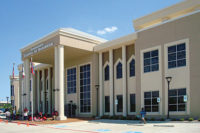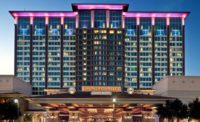Exterior insulation and finish systems have been a popular cladding choice for buildings for over 35 years in the United States and almost 50 years in Europe. This durable, lightweight and versatile cladding is offered in a variety of colors and textures. The existing inventory of EIFS clad buildings has created an opportunity for contractors and manufacturers to offer solutions to restore the building’s exterior skin. EIFS manufacturers have developed programs or steps that can be taken to renew or restore an existing EIFS building. This has become a popular option for other cladding types such as brick, precast and stone. A meeting with the owner to determine possible options and expected return on investment is recommended to assess the feasibility of any work to the structure.
Evaluation of the Cladding
The first step in determining the appropriate method for restoring an existing building is to evaluate the condition of the cladding. This includes a site assessment to determine the scope of work to be completed and what type of restoration options are possible for the building. The assessment combines a thorough interview with the owner or maintenance personnel with an evaluation of the condition of the cladding, sealant, flashing and connections or penetrations through the building to determine what items need to be repaired or replaced. Evaluation methods could include thermal scans for heat loss and to identify locations of moisture penetration.
It is important that the key performance components of the cladding are present and working as intended. Those components include flashings, thermal control layers, air control layers and moisture control layers. Questions you must answer: were they designed properly? Are they connected to the next material properly and are they working as intended? Are they meeting today’s needs of the client? After the scope of work has been determined, a budget is set aside to complete the work.
Selection of the Contractor
Selecting the right contractor for any project is an important step to ensure a successful installation. The contractors who are biding the project should be pre-qualified based on their experience and skill level. Product submittals and color samples should be approved and accepted prior to the start of any work. A complete submittal should include the scope of work the contractor intends to perform, manufacturer’s product data sheets, specifications, material data sheets, color charts and texture samples and a list of references. Ask the contractor to provide a list of projects they have completed that are similar in size and scope to ensure the contractor is qualified to perform the work.
Cleaning the Exterior Skin
An important step to renew and restore an exterior cladding is the cleaning process.
Proper cleaning to remove any surface contaminants prepares the substrate and promotes the adhesion of the air barrier, basecoat or coating application. Mildew on the cladding can be removed by applying a solution of 2 cups of tsp to 1 gallon of water. The solution is applied using a plastic bristle brush and rinsed with water from a garden hose. Pressure washing is a more effective method of cleaning the substrate for larger wall surfaces and multi-story buildings.
Clean and Recoat
Clean and recoat is one of the most common methods for renewing a building’s exterior skin. Once the cleaning has been completed and the substrate is dry, a new coating is applied. Most manufacturers recommend a minimum of one coat of primer and one coat of the coating applied to the substrate. A three coat option with one coat of primer and two coats of the coating is a better option and will extend the life of the coating at a minimal cost to the owner. The next step is to remove the existing sealant and backer rod and install new. Any connections or penetrations through the cladding and flashing are typically repaired or replaced at this time.
Repair and Refinish
Repair and refinish is a common method to renew the exterior surface of an EIFS cladding. Repair and refinish consists of addressing any damage or punctures in the exterior skin as the first step. The next step in the process is the selection of basecoat to be used, in some cases where additional protection of the substrate is recommended a waterproof basecoat is applied. A fiberglass mesh embedded into the basecoat reinforces the surface of the EIFS cladding to increase impact resistance and resistance to cracking. The application of a primer is recommended over the basecoat prior to installing the finish. The benefit of using a primer is to provide a uniform color over the basecoat and extend the working time of the finish.
Overclad
Any building, regardless of the cladding type can be overclad with an EIF system. Overcladding is an economical and effective method to increase the energy efficiency of the structure by adding continuous insulation. This has been a popular option with owners who are retrofitting an existing building to meet new energy codes. A dew point analysis should be performed by the cladding manufacturer or design professional to determine the optimal amount of insulation to add to the structure. Critical details, door and window returns, parapet and window pan flashing should be considered since they may need to be re-worked to allow for the application of thicker insulation. A qualified design professional should be consulted if an overclad assembly is selected.
Remove and Re-clad
If there is extensive damage to the substrate and structure, removing the existing cladding and installing a new cladding is the best option. An engineer or third party inspector should be consulted to determine the scope of the repairs to the project. Once the cladding is removed, any damage to the structure is repaired and new framing and sheathing is installed. After the sheathing application is completed, the fluid applied air barrier is installed to weatherproof the structure. The fluid applied air barrier can be exposed to the elements for up to six months prior to the application of the EIF system. This is an advantage over traditional air barriers especially if the work schedule is during inclement weather conditions. Windows play an important role in the cladding performance. Often the re-cladding of a structure will include high performance windows that contribute to the overall performance of the assembly.
Specialty Finish Options
A new development in the EIFS industry was the introduction of finishes with super-hydrophobic self-cleaning properties, rinsing clean with rainfall. A major advantage of the finish is its high resistance to mold, mildew, and algae which reduces maintenance costs. The finish is available in various colors and three textures. A smooth coating is also available to apply over existing EIFS surfaces and other exterior substrates.
EIFS offers specialty finishes that replicate brick, granite, limestone, metal panels and precast. These finishes are easier to install and require fewer specialty trades than traditional cladding materials. Specialty finishes offer a cost-effective aesthetic option, increase energy efficiency and moisture protection. The finishes offer an identical look to the natural cladding, but are less heavy, and typically require no additional structural design or modifications to support the new look.
Maintenance
Proper maintenance of any cladding is crucial to the longevity of the structure and protect the owner’s investment. There are a few simple steps to maintain a cladding such as cleaning and conducting a site observation. It is important to perform an observation of the building every three to five years to inspect the condition of the coating, sealant joints, and parapet coping. This can be performed by the facility manager, maintenance manager of the property or the contractor. A contractor or third party inspector can also be contacted to perform a site assessment to determine if any repairs are necessary. If there are any repairs to be completed after a site observation, please refer to the manufacturer’s printed information or industry recommendations for the appropriate repair procedure.
Conclusion
Any building, regardless of the cladding can be restored with an EIFS coating, cladding or finish system to regain the value of the owner’s original investment. Proper evaluation of the existing cladding is essential to determine the appropriate repair procedure for the project. If there is extensive damage to the building, a qualified engineer or third party inspector should be consulted to determine the scope of the repairs and procedure. Routine inspection and maintenance is crucial to extend the life of the structure, regardless of the cladding.












